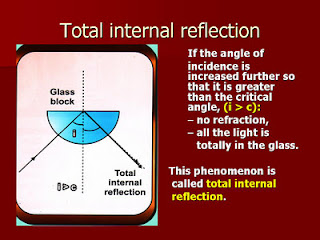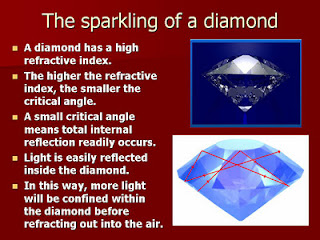Saturday, 18 February 2012
Longitudinal and Transverse Wave Motion
Longitudinal Waves
In a longitudinal wave the particle displacement is parallel to the direction of wave propagation. The animation below shows a one-dimensional longitudinal plane wave propagating down a tube. The particles do not move down the tube with the wave; they simply oscillate back and forth about their individual equilibrium positions. Pick a single particle and watch its motion. The wave is seen as the motion of the compressed region (ie, it is a pressure wave), which moves from left to right.
The P waves (Primary waves) in an earthquake are examples of Longitudinal waves. The P waves travel with the fastest velocity and are the first to arrive.
To see a animations of spherical longitudinal waves check out:
Transverse Waves
In a transverse wave the particle displacement is perpendicular to the direction of wave propagation. The animation below shows a one-dimensional transverse plane wave propagating from left to right. The particles do not move along with the wave; they simply oscillate up and down about their individual equilibrium positions as the wave passes by. Pick a single particle and watch its motion.
The S waves (Secondary waves) in an earthquake are examples of Transverse waves. S waves propagate with a velocity slower than P waves, arriving several seconds later.
Water Waves
Water waves are an example of waves that involve a combination of both longitudinal and transverse motions. As a wave travels through the waver, the particles travel in clockwise circles. The radius of the circles decreases as the depth into the water increases. The movie below shows a water wave travelling from left to right in a region where the depth of the water is greater than the wavelength of the waves. I have identified two particles in yellow to show that each particle indeed travels in a clockwise circle as the wave passes.
Rayleigh surface waves
[The following animation was produced with a Mathematica notebook, Rayleigh-v8.nb, which I created to investigate the behavior of Rayleigh waves which occur in solids. This Mathematica notebook contains several other graphs which further analyzer the behavior of Rayleigh waves.]Another example of waves with both longitudinal and transverse motion may be found in solids as Rayleigh surface waves (named after John W. Strutt, 3rd Baron Rayleigh). The particles in a solid, through which a Rayleigh surface wave passes, move in elliptical paths, with the major axis of the ellipse perpendicular to the surface of the solid. As the depth into the solid increases the "width" of the elliptical path decreases. Rayleigh waves are different from water waves in one important way. In a water wave all particles travel in clockwise circles. However, in a Rayleigh surface wave, particles at the surface trace out a counter-clockwise ellipse, while particles at a depth of more than 1/5th of a wavelength trace out clockwise ellispes. The movie below shows a Rayleigh wave travelling from left to right along the surface of a solid. I have identified two particles in yellow to illustrate the counterclockwise-clockwise motion as a function of depth.
The Rayleigh waves in an earthquake are the waves that cause the most damage during. They travel with velocities slower than S waves, and arrive later, but with much greater amplitudes. These are the waves that are most easily felt during an earthquake and involve both up-down and side-to-side motion.
Monday, 6 February 2012
waves can cause this massive wave in the ocean.
DO YOU KNOW?
Tsunami waves do not resemble normal sea waves, because their wavelength is far longer. Rather than appearing as a breaking wave, a tsunami may instead initially resemble a rapidly rising tide, and for this reason they are often referred to as tidal waves. Tsunamis generally consist of a series of waves with periods ranging from minutes to hours, arriving in a so-called "wave train".Wave heights of tens of metres can be generated by large events.
DO YOU KNOW?
Tsunami waves do not resemble normal sea waves, because their wavelength is far longer. Rather than appearing as a breaking wave, a tsunami may instead initially resemble a rapidly rising tide, and for this reason they are often referred to as tidal waves. Tsunamis generally consist of a series of waves with periods ranging from minutes to hours, arriving in a so-called "wave train".Wave heights of tens of metres can be generated by large events.
LET SURF IN THE WAVES!
Hello there loyal readers, hope you are in your best of your life can give. give what it takes to be who you are and never look down no matter what it takes! Well folks, this entry would mark a new whole chapter in the first form 5 chapter, ( yay! learning something new =)
yup, in fact as the starting of the new one, we will something interesting which is something related with our daily life. the one that enable us to talk, listen and even spying!like the old 007 movies ( ohh how i really love to watch it).. yup people, today we are going to learn about WAVES!,
Before we start just have a glance of what are we going to learn:
Wednesday, 25 January 2012
Subscribe to:
Comments (Atom)













































